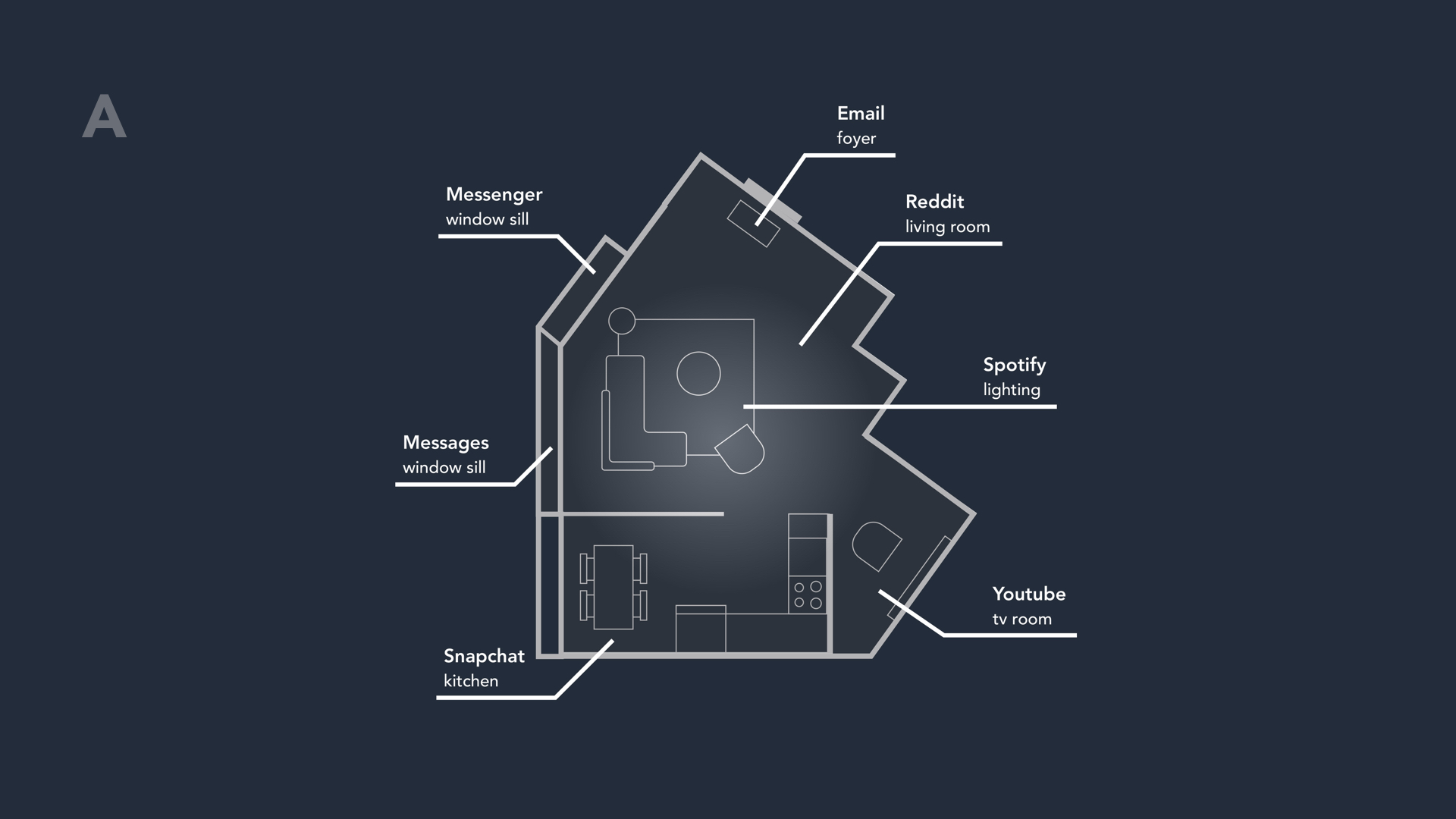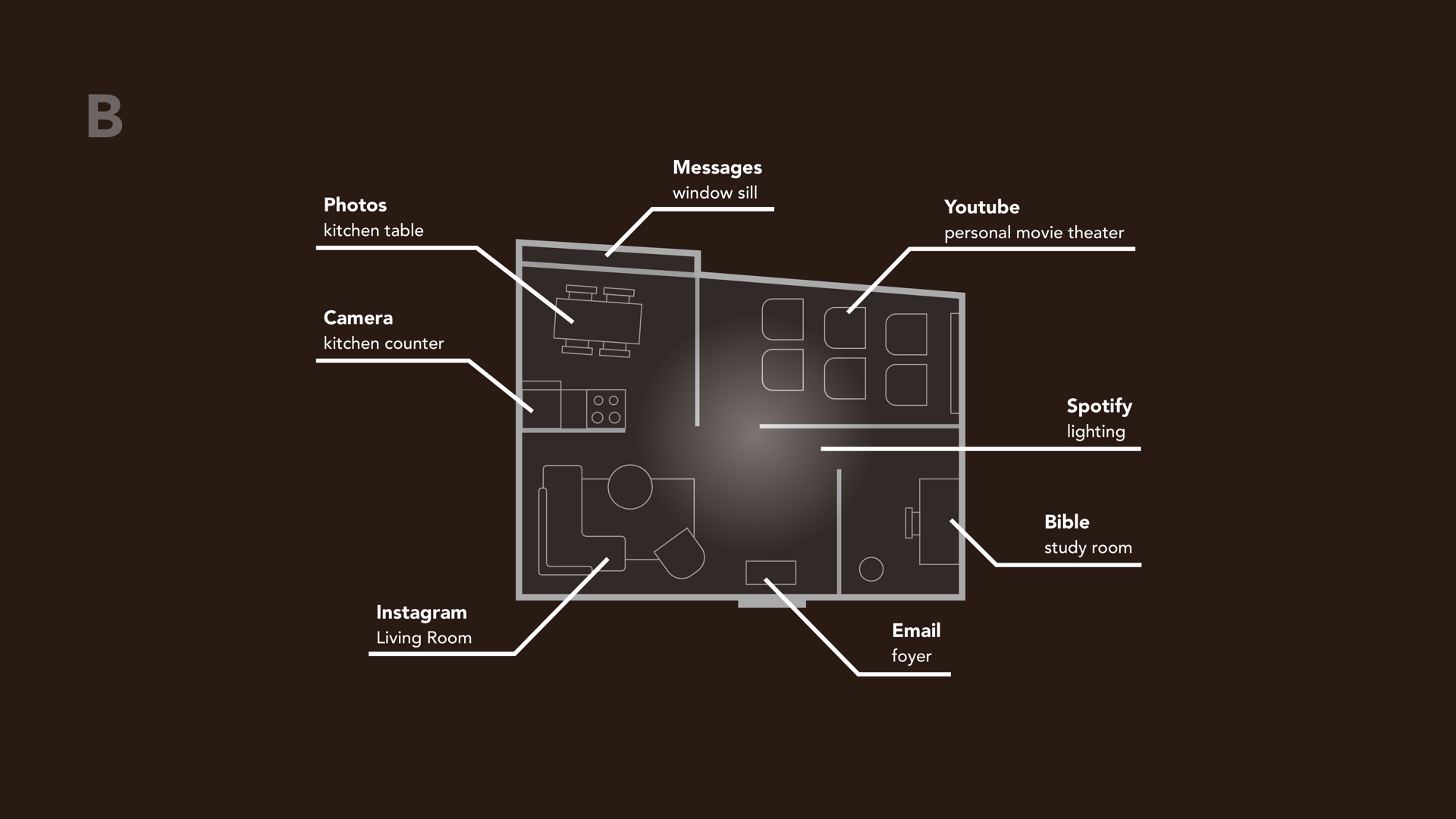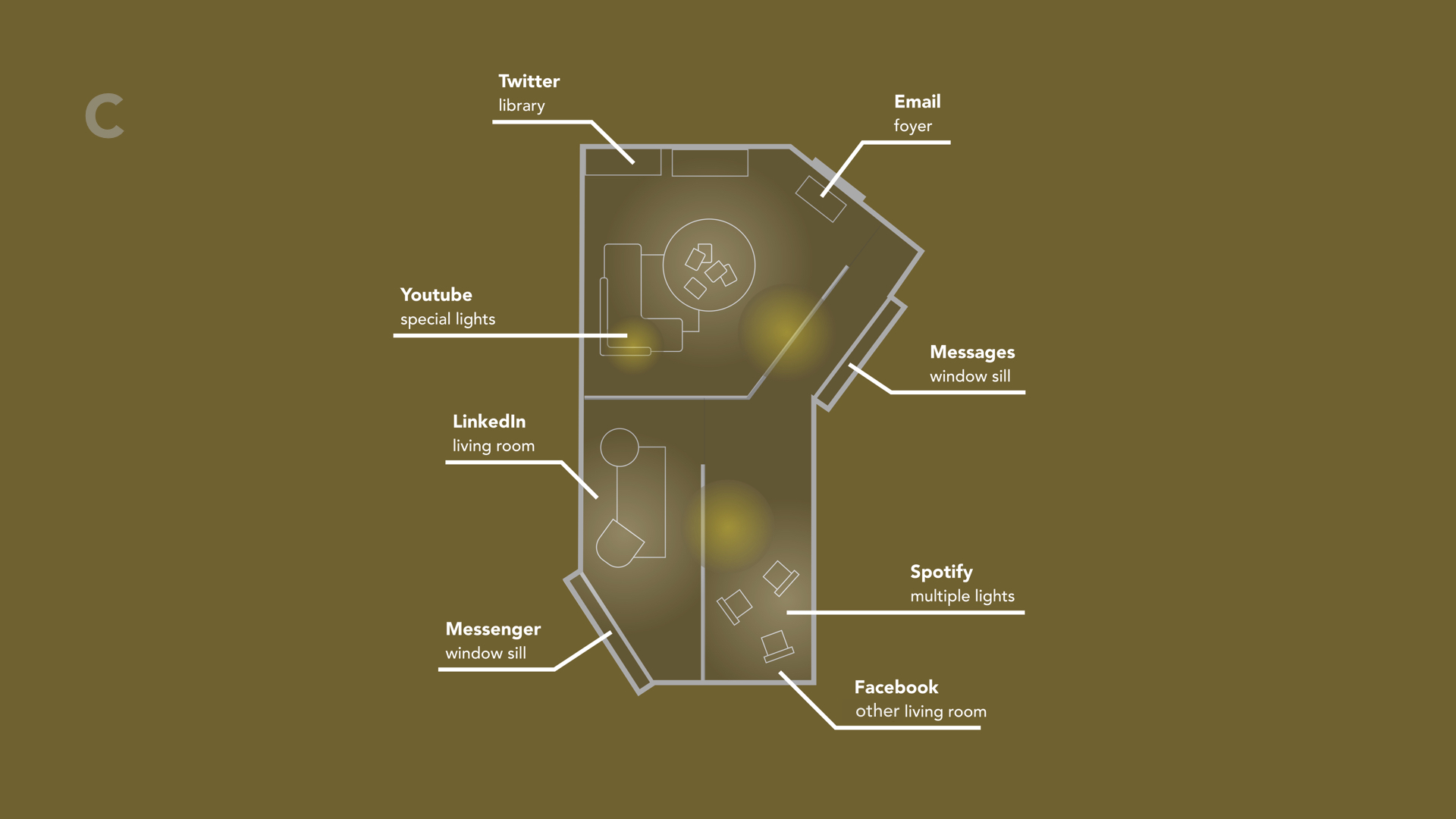Software as Spaces
Mapping our digital homes
Individual work completed for Environments Studio IV.
A research project focused on understanding how the digital products people use form a wider picture of themselves. The end result was a series of floor plans in which each room or item represented an app in a metaphorical home.
Part 1: Creating a Concept
Just as we have rooms we occupy in our houses or places we frequent in our neighborhoods, we have different websites associated with different tasks, moods and activities. I wanted to research these virtual environments to better understand them.
Some information I could wanted to yield from this is individual differences (why is one person’s entertainment space Netflix while another’s is Youtube) how people spend their time (and what that reveals about their values) and where people consider their default space to be (and why?).
Outlining My Digital Space
To get a better idea of what I was looking for, I started out by making a rough outline of my own digital space. When doing this, I thought it worthwhile to distinguish the devices within which these digital spaces exist. This is because the affordances of each of the products influence the way that I interact with the software on them.
Part 2: Defining a deliverable
Based on these initial thoughts, I considered a few different directions that I could take the project in.
1. Mixing and Matching Different Styles of Websites (What would Gmail be like if it was arranged like Youtube?)
Different websites have different visual formats. These formats affect the way we use them and even how long we spend on them. It would be interesting to categorize each format and then transpose websites onto different formats.
2. Visually Mapping People's Digital Homes
Everyone has their own set of sites that they frequent. It would be interest to map out these sites and see the similarities and differences among them. Does everyone have a different floor plan? Or are the floor plans mostly the same but populated with different sites?
3. Considering ‘Doors,’ or Methods of Transportation, Between Sites
There are many ways to travel between sites. You can access a site by typing a URL into a browser, or click on a link to that site while on another one. It would be interesting to research movement patterns between sites and why some some websites act as entryways into others.
creating Floor Plans of Digital Homes
I went with option 2 and chose to create a series of floor plans that mapped peoples digital habits to a physical floor plan. I selected this one because I thought that it would make for a compelling deliverable and incorporate some some of the interesting aspects of the other two options as well.
Some elements that I wanted to explore in my maps were:
Rooms: One could think of the websites and apps we use regularly as rooms in a digital house. Just like rooms, we spend different amounts of time in different rooms and use them for varying purposes.
Doors: Just as we move from room to room via doors or openings, we travel from one application to another via gateways. This can be as straightforward as typing a URL into a browser or as subtle as clicking a link on a page.
Floor Plan: If seen from the right perspective, these applications make up a larger floor plan. Just as someone’s house reveals information about themselves, I predicted that someone’s digital floor plans can reflect their habits, values, and personality.
Walls/Windows: The final factor to consider is how people occupy the digital rooms that they're in. Some houses contain open floor plans, while others are closed off. Digital applications can work in a similar way, with some enabling multitasking while others opposing it.
Part 3: Conducting Interviews
I mapped out 3 people’s digital homes, taking into consideration the factors mentioned above. Most of my information was gathered from user interviews. For consistency’s sake, I limited consideration of ‘devices’ to mobile phones (initially I chose laptops but decided to change it when I realized that the mental model for apps that existed on phones conveniently segmented software).
Procedures
These are steps that I followed when conducting my interviews:
1. Determine Most Used Apps: First, I asked each individual to open up their phone, go into settings, then battery usage, and show me what their most used apps were for the past day or week.
2. Discuss App Usage: After listing the apps, I went down the list and asked how and why the individual used each one.
3. Discover What Prompts Entrance to Apps: I then went through the list of apps again, now specifically asking what prompts the users to enter these apps (association with a specific time of day, due to receiving a notification, or simply a result of boredom were common causes).
4. Evaluate Multitasking: Finally, I went through the list one last time and ask if and how the individuals multitask while on the apps. In addition, I asked how likely the users are to leave each app if he/she receives an external notification while in the app.
5. Look at App Organization: Lastly, I asked the users to take out their phones again and briefly discuss how they chose to organize their apps and what that might reveal about their usage habits.
Subjects
The bios of the three subjects I interviewed:
Part 4: Creating the Maps
Based on the information I gleamed from the interviews, I created these three maps to illustrate the digital habits of my subjects.



Reflection
Many interesting observations can be made from the results of this project. I was fascinated with how apps like Gmail were used in a very consistent manner while Youtube was used differently by each person. Similarly, some spaces, such as the living room or kitchen, were occupied by different apps for each person even though they served similar functions.
Finally, I found it interesting how people’s floor plans reflected their actions, and in some cases, how they were trying to change them. For instance, Person C’s primary space is twitter, which fulfills the role of a library. This was a conscious choice that she was making to avoid what she perceived as wasting time by defaulting to scrolling through Facebook.
Making these maps was not always as straightforward as I would have liked. As metaphors, they are bound to be imperfect. However, I greatly enjoyed the process. I feel that if I were to interview more people and construct a wider array of floor plans, interesting discoveries could be made about user patterns and competition among apps.
In addition, if I were to conduct these interviews again, I would have liked see the subjects map out their own floor plans to see how their interpretations differed from mine
Maayan Albert © 2020 | maayan.albert@gmail.com











